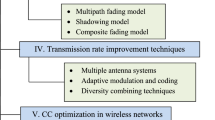Abstract
In this paper, we discuss the potential of wireless systems employing multiple antenna elements at both sides of the link. Diversity gain and multiplexing gain are explained and related coding techniques allowing to realize these gains are presented.
Zusammenfassung
In diesem Beitrag werden Diversitäts- und Kapazitätsgewinne diskutiert, die im Funkbereich durch die Verwendung von Gruppenantennen auf beiden Seiten der Übertragung erzielt werden können. Einfache, aber wirkungsvolle Codiertechniken, mit denen beträchtliche Gewinne erzielt werden können, werden vorgestellt und erklärt.
Similar content being viewed by others
References
Alamouti, S. M. (1998): A simple transmit diversity technique for wireless communications. IEE J. Sel. Areas Comm., vol. 16, Oct.: 1451–1458.
Biglieri, E., Divsalar, D., McLane, P. J., Simon, M. K. (1991): Introduction to Trellis-coded modulation with applications. New York: Macmillan.
Bölcskei, H., Gesbert, D., Paulraj, A. J. (2002): On the capacity of OFDM-based spatial multiplexing systems. IEEE Trans. Comm., Feb: 225–234.
Bölcskei, H., Paulraj, A. (2000): Space-frequency coded broadband OFDM systems. In: Proc. IEEE WCNC-2000, vol. 1, (Chicago, IL): 1–6.
Damen, O., Chkeif, A., Belfiore, J.-C. (2000): Lattice code decoder for space-time codes. IEEE Communications Letters, vol. 4, May: 161–163.
Foschini, G. J. (1996): Layered space-time architecture for wireless communication in a fading environment when using multi-element antennas. Bell Labs Tech. J., Autumn: 41–59.
Foschini, G. J., Golden, G. D., Valenzuela, R. A., Wolniansky, P. W. (1999): Simplified processing for high spectral efficiency wireless communication employing multi-antenna arrays. IEEE J. Sel. Areas Comm., vol. 17, no. 11: 1841–1852.
Golden, G. D., Foschini, G. J., Valenzuela, R. A., Wolniansky, P. W. (1999): Detection algorithm and initial laboratory results using the V-BLAST space-time communication architecture. Electronics Letters, vol. 35, no. 1: 14–15.
Guey, J., Fitz, M., Bell, M., Kuo, W. (1996): Signal design for transmitter diversity wireless communication systems over Rayleigh fading channels. In: Proc. IEEE VTC, 1996: 136–140.
Hochwald, B. M., Marzetta, T. L. (2000): Unitary space-time modulation for multiple-antenna communications in Rayleigh flat fading. IEEE Trans. Inf. Theory, vol. 46, no. 2: 543–564.
Jakes, W. C. (1974): Microwave mobile communications. New York: Wiley.
Kuo, W. Y., Fitz, M. P. (1997): Design and analysis of transmitter diversity using intentional frequency offset for wireless communications. IEEE Trans. Veh. Technol., vol. 46, Nov.: 871–881.
Marzetta, T. L., Hochwald, B. M. (1999): Capacity of a mobile multiple-antenna communication link in Rayleigh flat fading. IEEE Trans. Inf. Theory, vol. 45, Jan.: 139–157.
Paulraj, A. J., Kailath, T. (1994): Increasing capacity in wireless broadcast systems using distributed transmission/directional reception. U. S. Patent, no. 5,345, 599.
Raleigh, G. G., Cioffi, J. M. (1998): Spatio-temporal coding for wireless communication. IEEE Trans. Comm., vol. 46, no. 3: 357–366.
Seshadri, N., Winters, J. (1994): Two signaling schemes for improving the error performance of frequency-division-duplex (FDD) transmission systems using transmitter antenna diversity. Int. J. Wireless Information Networks, vol. 1, no. 1: 49–60.
Tarokh, V., Jafarkhani, H., Calderbank, A. R. (1999): Space-time block codes from orthogonal designs. IEEE Trans. Inf. Theory, vol. 45, July: 1456–1467.
Tarokh, V., Seshadri, N., Calderbank, A. R. (1998): Space-time codes for high data rate wireless communication: Performance criterion and code construction. IEEE Trans. Inf. Theory, vol. 44, March: 744–765.
Telatar, I. E. (1995): Capacity of multi-antenna Gaussian channels. Tech. Rep. #BL0112170-950615-07TM, AT & Bell Laboratories.
Wittneben, A. (1993): Base station modulation diversity for digital SIMULCAST. In: Proc. IEEE VTC, May: 505–511.
Author information
Authors and Affiliations
Rights and permissions
About this article
Cite this article
Bölcskei, H., Weinrichter, H. An overview of coding techniques for fading channels using multiple antenna elements. Elektrotech. Inftech. 119, 376–380 (2002). https://doi.org/10.1007/BF03160507
Issue Date:
DOI: https://doi.org/10.1007/BF03160507




